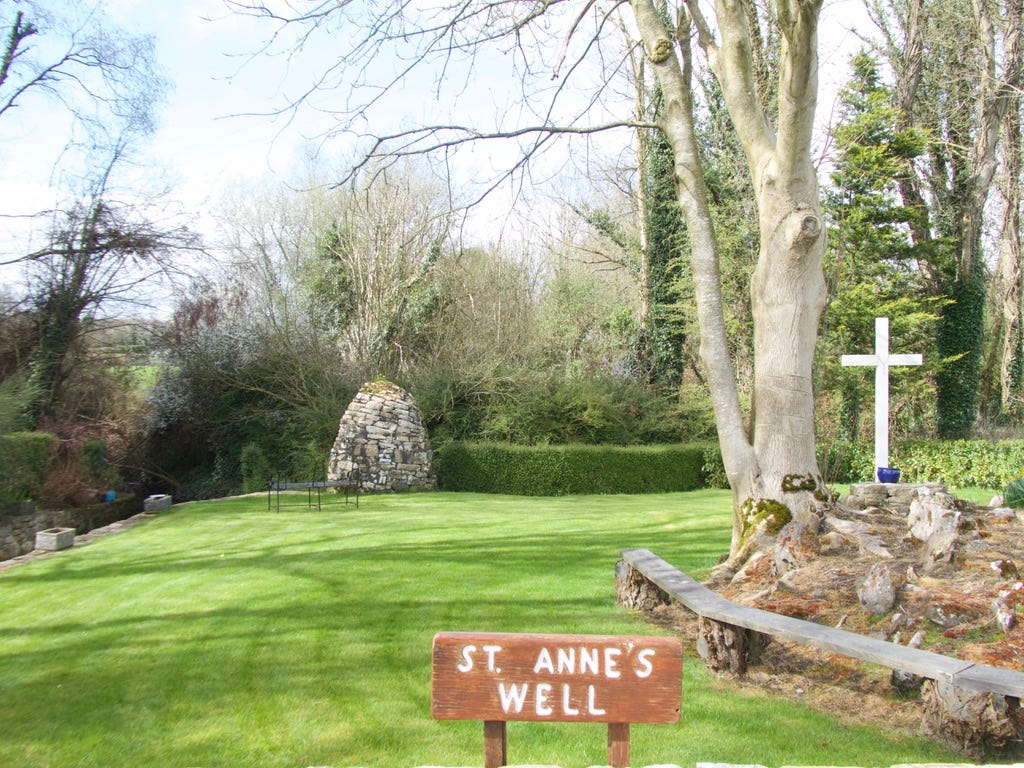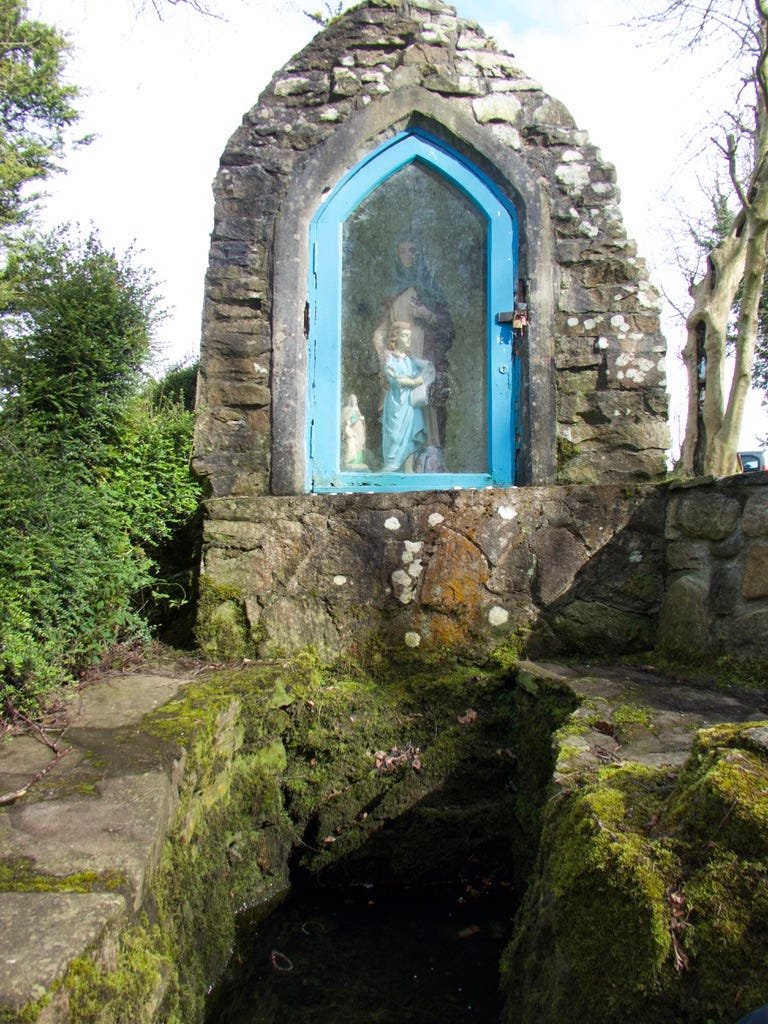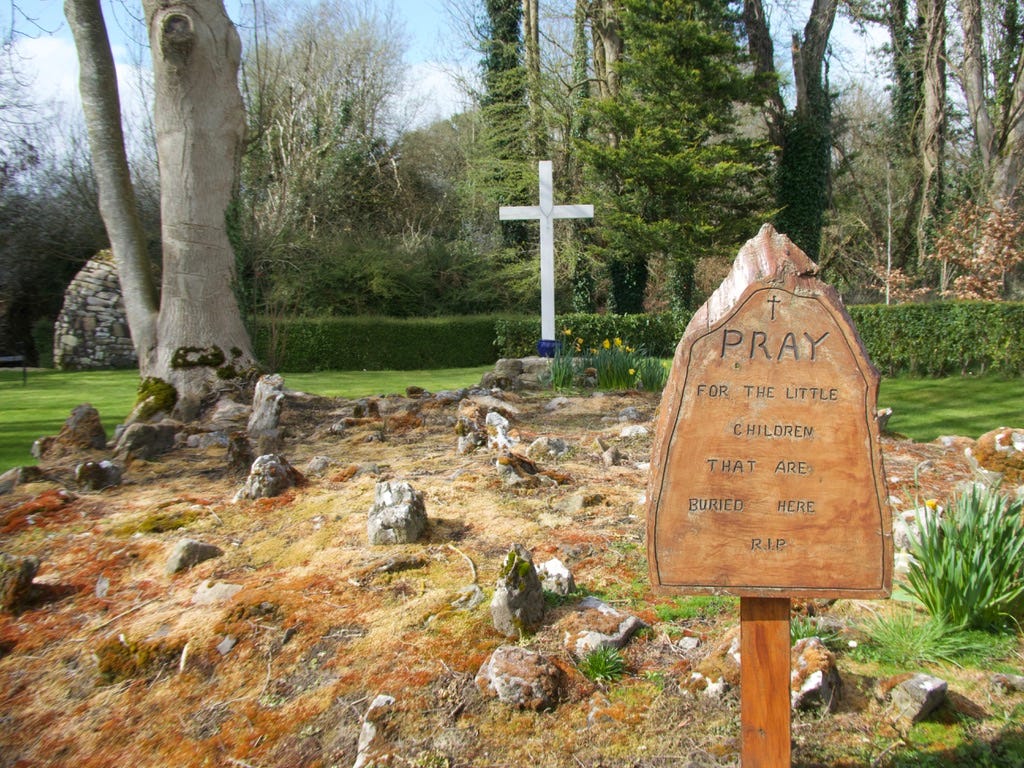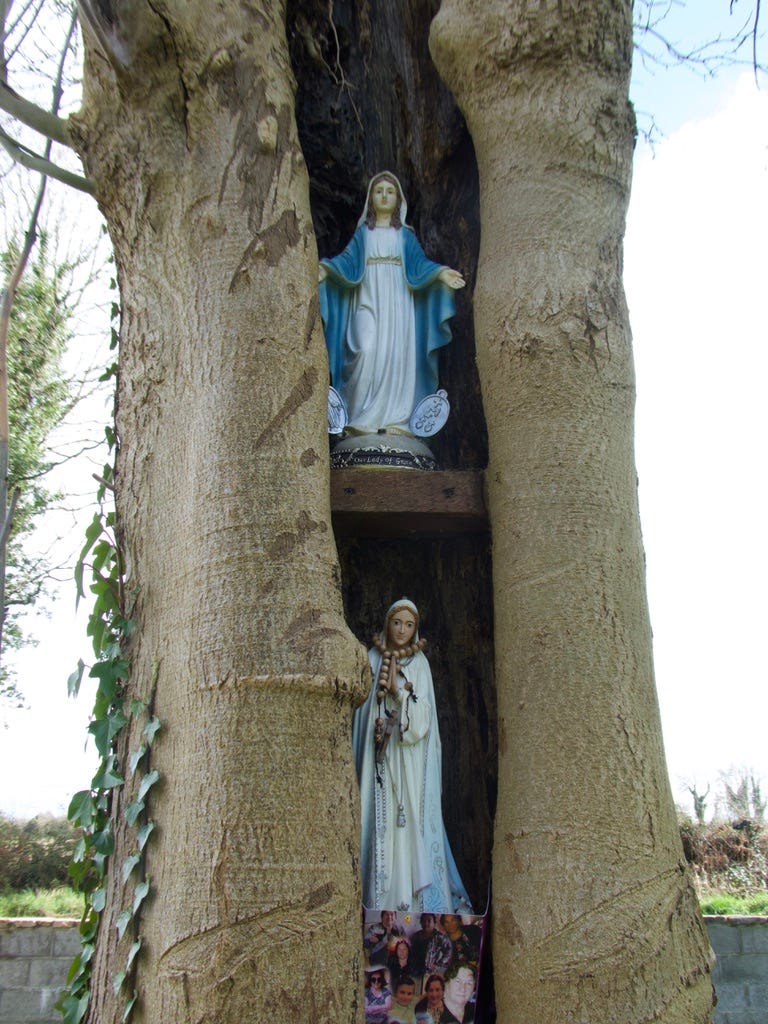St Anne’s Well, Gorteeny, County Clare
It’s a sunny April day when I turn down a small side road near Lough Derg in County Clare on my way back from the morning school run. I’m not really going anywhere, it’s just that I pass this road every morning and I’ve never known where it goes. Sometimes I like to head down lanes and get lost. Getting lost is itself becoming a lost art. Somebody could write a book about it, if anybody still read books; but the art of reading is going the same way as the art of wandering aimlessly. If you want to know where something is today, you just Google it, and the little Satanic Rectangle in your hand obligingly offers up a characterless, inhuman little blue line to follow, precise to the last gigamillimeter, with the help of all the satellites spying on you every second from space. You don’t have to know how to read a map, or even where you are in the landscape. The Machine has your back.
Well, humbug to it. One reason I have neither a smartphone nor a satnav is that I like getting lost. I don’t want Elon’s Starlink to tell me precisely where I am. I reserve the right to know neither where nor who I am, for as long as I damn well like.
Perhaps I was in this mood back in April when I turned down the lane that led to St Anne’s Well. I hadn’t known there was a well down here, but there it is, waiting for me in the sun. There was nobody else around when I pulled up. I crossed myself at the gate - a good habit to get into - and walked in. This is a well-tended (sorry) place, which the local people obviously care for and keep clean. The neatly clipped grass is bounded by a stream edged with stone walls, which itself is a tributary of a wilder stream that flows in from the fields. The well rises by the bank of the stream, and its waters flow off into it.
Above the spring stands a statue of St Anne, mother of the Virgin Mary, in a glass case to protect it from the Atlantic weather:
Moss grows up the walls of the stone well. A rag tree above it has a few offerings hanging from it. Open the door of St Anne’s little chamber and you will find a selection of typical offerings: rosaries, pendants, rings, coins, family photographs, funeral cards. All of the aids to prayer of the local faithful.
But there is something else here too, something that feels incongruous in the spring sunshine. There is a rough mound of earth, studded with shards of broken limestone like the teeth of some ancient fossilised beast. The rest of the site is so neat as to appear almost suburban, but this hill, topped with a stark white cross, seems older and rougher. It doesn’t fit. By the roadside, carved into wood, is a sign that explains why:
What we have here is a cilliní. In English, it’s usually called a killeen or a kyle, and if you see those prefixes in an Irish place name, this is why. It’s a burial place for children who died without being baptised, and to me it is one of the grimmest legacies of the Roman Catholic church’s horrible, and now quietly abandoned, teachings about the nature of life after death, and who gets to partake of it. There are hundreds of cilliní all over Ireland, and they are mournful places. I don’t know if they are unique to this country, but they are certainly numerous here, and their existence is due to an argument over the nature of sin.
The Christian Church has always taught that humans are ‘fallen’ creatures: that we are in some way bent out of shape; that we are not as our maker intended us to be. The Great Schism of 1054, when the Roman Bishopric broke away from the rest of the Church, and the Reformation of the sixteenth century, when dissidents split in turn from the Roman church, splintered the Christian world into shards, but all of those shards still share this teaching. Christians believe that every human is an inheritor of the sin of the first humans. What they disagree about is what ‘inheritor’ means.
It’s worth noting here that ‘sin’ is originally an archery term: it literally means ‘to miss the mark.’ Adam and Eve, the original humans, missed the mark by rebelling against God and the laws of creation. This set future humans up, according to the version of the story told by the Eastern Orthodox Church, for an ‘inclination towards sin, a heritage from the sin of our progenitors.’ What this means is that all human beings have an inbuilt tendency to rebel against God, and a tendency instead to follow the path offered by the serpent in Eden - the path that leads us to try and ‘become like gods’ ourselves. The purpose of the Christian Way is to root out this tendency, and thus to help us return to our intended state as ‘God-bearers.’
The Roman Catholic church has always seen the matter differently. Beginning with the teachings of St Augustine, Christians in the West taught that what Augustine called ‘Original Sin’ was personally inherited: in other words, that every human born on Earth inherits not simply a tendency to rebel against God, but personal responsibility - and thus personal guilt - for the actions of their ancestors. It is interesting to see that this notion has made a comeback today on the secular left, which likes to talk, for example, of the inherited sin of ‘whiteness,’ and the consequent guilt that all Western people bear for various historical crimes which their ancestors may or may not have committed. Politics is often just sublimated religion.
The only way to wash away the guilt of Original Sin, in the Catholic tradition, is through baptism. But a question quickly arises: what happens to people who are unbaptised? This, of course, includes every non-Christian human being, and everyone who existed before Christ, as well as Christians who die young before they can be baptised. What is their fate to be in the next world?
According to St Augustine, the answer was straightforward: they all go straight to hell. This is a useful reminder that even saints can be wrong. Rebelling against the grimness of this teaching, later Catholic thinkers, notably Thomas Aquinas, sought to sweeten the pill. The unbaptised, theorised Aquinas, rather than burning in eternal fire, instead enter an intermediary state between heaven and hell, which, from the Latin limbus, meaning boundary, came to be known as ‘Limbo.’
The unbaptised, headed as they were for Limbo, could not be buried in consecrated ground, and so, in Ireland, the cilliní arose. A child who died soon after birth, before there was a chance for baptism, would be taken to the cilliní at night, with no ceremony, according to a historian who has studied these burial grounds:
The sad journey to the cillin was conducted by a male member of the family and in darkness. Other family members were not encouraged to recognise the birth of the child or to accompany it on its final journey.
And the poor mother was not supposed to hold her baby or mourn it although it is a certainty that many made it their business to make secret and lonely journeys to mourn their lost children.
One Irish woman, whose sister died a day after her birth in 1954, remembers how her sister was buried in one of these places:
As was customary then my dad had to take her little body late at night well after dark to an old graveyard and on the perimeter of the graveyard. My dad had to bury her with no grave markings (an unknown grave). But at the time he made a little cross shape tied together with twine, made from two sticks and stuck them in the ground. Every year my dad used to take me to Marian's grave to say a little prayer.
So much for God’s boundless love. If you want to know why Catholic Ireland collapsed so fast at the end of the twentieth century, I’d say that places like this, and the teachings behind them, were at least partly responsible. The Catholic church finally appeared to agree, quietly dropping, at the Second Vatican Council in the 1960s, the need for the unbaptised to be buried in places like this, and rowing back on the notion of Limbo too, which it doesn’t like to talk about much anymore. The previous Pope, Benedict XVI, who was also a noted theologian, proclaimed that ‘Limbo has never been a definitive truth of the faith’, and research shows that belief in it is disappearing fast amongst the Catholic faithful.
Visiting a cilliní will show you, better than any university research paper, why this is the case. The Roman Catholic church is unique in the Christian world in having believed in both Limbo and Purgatory, two notions unknown in the early Church and unreferenced in the Bible, and the notion that all humans automatically inherit grievous personal sin at birth was drummed into Catholics here and elsewhere. It explains, if you ask me, the sense of darkness that can sometimes permeate the historic Irish Church, especially in the period after the Reformation. I’m no theologian, but I can’t see how the God of the Gospels could have any truck with Christian mothers weeping as their dead babies are buried at night in unmarked graves.
Nobody mourns the loss of the cilliní. But this one, at least, is still watched over by both the saints and the trees. The good news is that the well waters still flow, and so does God’s love. We have to hope that everything is healed at the end.









I'm glad you tackled the issue of the Killeen's Paul. You are right, they are dotted all around Ireland. For me, they are a reminder of how dark and unforgiving the Church I was brought up in could be. You are I suspect right, the phenomenally rapid collapse in the moral authority and "hold" the RC Church had on the people of Ireland is I suspect a form of "payback" for this, and I'm sorry to add, numerous other mean and unloving aspects of Roman Catholic hegemony in Ireland.
What is remarkable to me is that this change has occurred within my life time. As a child in the 1960s, staying the long summer holidays in rural Kerry at my Grandparents small farm, I remember that most of the Irish people I knew, were in thrall psychologically and emotionally to the Roman Catholic priesthood. This vanished like "snow off a dyke on a sunny morning" from the late 1980s onwards.
I have returned "home" to Ireland for the past 24 years, and in that time the RC Church has taken such a collective kicking from the new high priests of secularism in Irish cultural and political life who now determine Irish mores, that it has brought to mind the image of an aging gang boss being kicked to a pulp by a squad of tough young usurpers. Repeatedly receiving kicks to the head long after he had expired. The assailants continuing their booting and wounding of the ousted dead leader to extend the humiliation, and to emphasise to all of us watching, the fate that awaits anyone who thinks to challenge them.
For me, that's how it feels, we have a new "priesthood" here in Ireland, they pervade our media, cultural, and political life, and they possess every bit of the arrogance and rectitude of the Roman Catholic hierarchs of the 1930s or 1950s.
In the same way that poor old insecure and self doubting Ireland strove to be the most Catholic of all the Catholic nations of the earth, so too does Ireland in the 21st century take a strange pride in its "progressive" and "woke" credentials internationally, as ever, seeking verification and affirmation from those they consider to be the arbiters of all that is creditable and worthy.
Ireland in the 21st century looks to me like a nation that has "thrown the baby out with the bath water", an old and pungent saying, which is appropriate to a sense of absence and loss, which sadly has made Ireland increasingly similar in many ways to all the other cookie cutter small to medium sized secular liberal EU nations, with all the attendant dominant
'liberal values' which render them incapable of even perceiving, far less preventing, their eventual disappearance as distinct and vibrant nations.
There is a church near where I live in southern Germany where they discovered the remains of so-called "Traufenkinder", lit. "eaves children" - babies who died before they could be baptised, and who were buried not in the graveyard, but where rainwater would drip down from the church eaves. This water was believed to have been sanctified by contact with the church roof and thus blessed the unbaptised children lying below. An attempt by the anguished families to provide a kind of posthumous baptism.